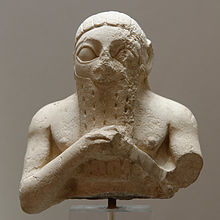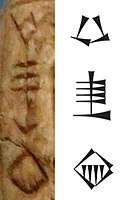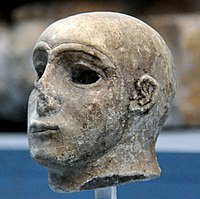Adab (city)
Adab, Udab | |
 | |
| Alternative name | Bismya |
|---|---|
| Location | Wasit Province,Iraq |
| Region | Mesopotamia |
| Coordinates | 31°56′49″N45°58′8″E/ 31.94694°N 45.96889°E |
| Type | tell |
| Site notes | |
| Excavation dates | 1885, 1890, 1902, 1903–1904 |
| Archaeologists | W.H. Ward,J.P. Peters,W. Andrae,E.J. Banks |

AdaborUdab(Sumerian:𒌓𒉣𒆠Adabki,[1]spelled UD.NUNKI[2]) was an ancientSumeriancity betweenGirsuandNippur.It was located at the site of modernBismayaor Bismya in theWasit ProvinceofIraq.The city-god of Adab was Parag'ellilegarra (Panigingarra) "The Sovereign Appointed by Ellil".[3][4]
Archaeology[edit]
The 400-hectare site consists of a number of mounds distributed over an area about 1.5 kilometres (0.93 mi) long and 3 kilometres (1.9 mi) wide, consisting of a number of low ridges, nowhere exceeding 12 metres (39 ft) in height, lying somewhat nearer to theTigristhan theEuphrates,about aday's journeyto the southeast of Nippur.
Initial examinations of the site of Bismaya were byWilliam Hayes Wardof the Wolfe Expedition in 1885 and byJohn Punnett Petersof theUniversity of Pennsylvaniain 1890, each spending a day there and finding onecuneiformtable and a few fragments.[5]Walter Andraevisited Bismaya in 1902, found a table fragment and produced a sketch map of the site.[6]
Excavations were conducted there for a total of six months, between Christmas of 1903 and June 1905, for theUniversity of Chicago,primarily byEdgar James Banks,with the final part of the dig being under engineer Victor S. Persons.[7]It proved that these mounds covered the site of the ancient city of Adab (Ud-Nun), hitherto known only from theSumerian King Listand a brief mention of its name in the introduction to theHammurabi Code.The city was divided into two parts by acanal,on an island in which stood thetemple,E-mach,with aziggurat,or stepped tower. It was evidently once a city of considerable importance, but deserted at a very early period, since the ruins found close to the surface of the mounds belong toShulgiandUr-Nammu,kings of theThird Dynasty of Urin the latter part of the third millennium BC, based on inscribed bricks excavated at Bismaya. Immediately below these, as atNippur,were found artifacts dating to the reign ofNaram-SuenandSargon of Akkad,c. 2300 BC. Below these there were still 10.5 metres (34 ft) of stratified remains, constituting seven-eighths of the total depth of the ruins. Besides the remains of buildings, walls, and graves, Banks discovered a large number of inscribed clay tablets of a very early period, bronze and stone tablets, bronze implements and the like.[8]

Of the tablets, 543 went to theOriental Instituteand roughly 1100, mostly purchased from the locals rather than excavated, went to the Istanbul Museum. The latter are still unpublished.[9]Brick stamps, found by Banks during his excavation of Adab state that the Akkadian rulerNaram-Suenbuilt a temple to Inanna at Adab, but the temple was not found during the dig, and is not known for certain to beE-shar.The two most notable discoveries were a complete statue in white marble, apparently the earliest yet found inMesopotamia,now in theIstanbul Archaeology Museums,bearing the inscription, translated by Banks as "E-mach, King Da-udu, King of, Ud-Nun", now known as the statue ofLugal-daluand a temple refuse heap, consisting of great quantities of fragments of vases in marble,alabaster,onyx,porphyryandgranite,some of which were inscribed, and others engraved and inlaid withivoryand precious stones.[8]
Of the Adab tablets that ended up at the University of Chicago, sponsor of the excavations, all have been published and also made available in digital form online. [10]Banks also purchased Adab tablets locally and sold them sold piecemeal to various owners over years. A few have made their way into publication.[11]
Though the Banks expedition to Bismaya was well documented by the standards of the time and many objects photographed, no final report was ever produced due to personal disputes. Recently, the Oriental Institute has re-examined the records and objects returned to the institute by Banks and produced a report.[8]
In response to widespread looting, the Iraq State Board of Antiquities and Heritage conducted an excavation at Adab in 2001. The site has now been largely destroyed by systematic looting, so further excavation is unlikely. On the order of a thousand tablets from that looting, all from the Sargonic Period, have been sold to various collectors and many are being published, though missing archaeological context.[12]
From 2016 to 2019, theUniversity of Bolognaand the Iraqi State Board of Antiquities and Heritage conducted a program, theQadissurvey, of coordinatedremote sensingand surface surveys in theQadisiyahprovince including at Bismaya. Results included a "Preliminary reconstruction of the urban layout and hydraulic landscape around Bismaya/Adab in the ED III and Akkadian periods".[13][14]A previously unknown palace was discovered and the extent of looting identified. It was determined that the city was surrounded by canals.[15]The Qadis survey showed that Adab had a 24-hectare central harbor, with a maximum length of 240 meters and a maximum width of 215 meters. The harbor was connected to the Tigris river via a 100-meter–wide canal.[16][17]
There is aSumeriancomic tale of theThree Ox-drivers from Adab.[18][relevant?]

Occupation history[edit]
Early Dynastic Period[edit]
Adab was occupied from at least theEarly Dynastic Period.According toSumeriantextInanna's descent to the netherworld,there was a temple ofInannanamedE-sharat Adab during the reign ofDumuzidofUruk.In another text in the same series,Dumuzid's dream,Dumuzid of Uruk is toppled from his opulence by a hungry mob composed of men from the major cities of Sumer, including Adab.
A king ofKish,Mesilim,appears to have ruled at Adab, based on inscriptions found at Bismaya. One inscription, on a bowl fragment reads "Mesilim,king of Kish, to Esar has returned[this bowl], Salkisalsi being patesi of Adab".[19]One king of Adab,Lugal-Anne-Mundu,appearing in theSumerian King List,is mentioned in few contemporary inscriptions; some that are much later copies claim that he established a vast, but brief empire stretching fromElamall the way toLebanonand theAmoriteterritories along the Jordan. Adab is also mentioned in some of theEbla tabletsfrom roughly the same era as a trading partner ofEblain northern Syria, shortly before Ebla was destroyed by unknown forces.[20]
A marble statue was found at Bismaya inscribed with the name of another king of Adab, variously translated as Lugal-daudu, Da-udu,Lugaldalu,and Esar.[21]
Sargonic Period[edit]
Meskigal, governor of Adab under Lugalzagesi of Uruk, changed allegiance to Akkad and became governor underSargon of Akkad.He later joined the Great Rebellion against Naram-Sin and was defeated. Various governors, including Sarru-alli and Lugal-ajagu then ruled Adab under direct Akkadian control. By the end of the Akkadian period, Adab was occupied by the Gutians, who made it their capital.[22]
Several governors of the city underUr IIIare also known. While no later archaeological evidence was found at Bismaya, the excavations there were brief, and there were later epigraphic references to Adab, such as in theCode of Hammurabi.
Rulers of Adab[edit]
| Ruler | Proposed reign | Notes | |
|---|---|---|---|
| Nin-kisalsi | c. 2600– c. 2500 BC | "Governor of Lagash" | |
| Lugaldalu | c. 2500– c. 2470 BC | Known from a statue | |
| E-iginimpa'e | c. 2470– c. 2450 BC | Contemporary withLugalzagesi | |
| Mug-si | c. 2450– c. 2430 BC | ||
| Lugalannemundu | c. 2430– c. 2340 BC | "King of the four quarters of the world" | |
| Meskigal | c. 2340 BC | Governor underLugalzagesiofUruk,Sargon of Akkad,andRimushof Akkad.[23] | |
| Lugal-ajagu | c. 2300 BC | Vassal governor under Akkadian Empire.[24] | |
| Ur-tur | c. 2250 BC | Vassal governor under Akkadian Empire in time of Sarkalisarri | |
| Urdumu | ? | Ensi,known from a seal |
Akkadian Governors of Adab[edit]
| Ruler | Proposed reign | Notes | |
|---|---|---|---|
| Lugal-gis | c. 2220 BC | Governor of Adab under Shar-Kali-Sharri (r. 2217-2193 BC) | |
| Ur-tur | c. 2200 BC | Governor of Adab under Shar-Kali-Sharri (r. 2217-2193 BC) | |
| Amar-Suba | c. 2180 BC | Governor of Adab under Dudu (r. 2189-2169 BC) |
Gallery[edit]
-
Seal of "Urdumu,Ensiof Udnunki "(" Urdumu, Governor of Adab ")
-
UD-NUN-KI, "City of Adab" on the statue ofLugal-dalu,with rendering in early Sumero-Akkadiancuneiform.
-
Headless votive statue, from Adab, Iraq, early dynastic period.Museum of the Ancient Orient,Turkey
-
Headless votive statue, from Adab, Iraq, early dynastic period.Museum of the Ancient Orient,Istanbul
-
Head of a votive statue, from Adab, Iraq, early dynastic period.Museum of the Ancient Orient,Turkey
-
Relief of a naked priest, from Adab, Iraq, early dynastic period.Museum of the Ancient Orient,Turkey
-
Cuneiform inscription on a statue from Adab, mentioning the name of Lugal-dalu and god ESAR of Adab
-
Headless statue, the name of the deity Ninshubur is mentioned on the right shoulder. From Adab. 2600-2370 BCE. Iraq Museum
See also[edit]
References[edit]
- ^The Sumerian King List.Accessed 15 Dec 2010.
- ^The Cambridge Ancient History.Vol. 1. Part 1.Prolegomena & Prehistory.
- ^Marchesi, Gianni and Marchetti, Nicolo, "Historical Framework", Royal Statuary of Early Dynastic Mesopotamia, University Park, USA: Penn State University Press, pp. 97-128, 2011
- ^Such-Gutiérrez, "Untersuchungen zum Pantheon von Adab im 3. Jt.", AfO 51, pp. 1–44, 2005-6
- ^Peters, John P. (1897).Nippur; Or, Explorations and Adventures on the Euphrates: The Narrative of the University of Pennsylvania Expedition to Babylonia in the Years 1888-1890.Putnam.
- ^Andrae, Walter (1903)."Die Umgebung von Fara und Abu Hatab".Mitteilungen der Deutschen Orient Gesellschaft.16:24–30.
- ^[1]Edgar James Banks, "Bismya; or The lost city of Adab: a story of adventure, of exploration, and of excavation among the ruins of the oldest of the buried cities of Babylonia", G. P Putnam's Sons, New York, 1912
- ^abcWilson, Karen (2012).Bismaya: Recovering the Lost City of Adab - Oriental Institute Publications 138(PDF).Chicago, Ill.: Univ. of Chicago Press.ISBN9781885923639.
- ^Yang, Chih (1989).Sargonic inscriptions from Adab.Changchun: Institute for the History of Ancient Civillizations.OCLC299739533.
- ^[2]Daniel David Luckenbill, "Cuneiform Series, Vol. II: Inscriptions from Adab", Oriental Institute Publications 14, Chicago: The University of Chicago Press, 1930
- ^Widell, Magnus (2002)."A Previously Unpublished Lawsuit from Ur III Adab"(PDF).Cuneiform Digital Library Journal.2.
- ^Al-Doori, R.; AL - Qaisi, R.; Al-Sarraf, S.; Al-Zubaidi., A.A (2002). "The final report of Basmaia excavations (first season)".Sumer.51:58–72.
- ^[3]Marchetti, Nicolò, et al., "New Results on Ancient Settlement Patterns in the South-Eastern Qadisiyah Region (Iraq). the 2016-2017 Iraqi-Italian Qadis Survey Project", Al-Adab Journal 123, pp. 45-62, 2017
- ^[4]Marchetti, Nicolò, et al. "The rise of urbanized landscapes in Mesopotamia: The QADIS integrated survey results and the interpretation of multi-layered historical landscapes." Zeitschrift für Assyriologie und vorderasiatische Archäologie 109.2, pp. 214-237, 1029
- ^[5]Marchetti, Nicolò, and Federico Zaina. "Rediscovering the Heartland of Cities", Near Eastern Archaeology 83, pp. 146-157, 2020
- ^Mantellini, Simone; Picotti, Vincenzo; Al-Hussainy, Abbas; Marchetti, Nicolò; Zaina, Federico (2024)."Development of water management strategies in southern Mesopotamia during the fourth and third millennium B.C.E."Geoarchaeology.39(3): 268–299.Bibcode:2024Gearc..39..268M.doi:10.1002/gea.21992.hdl:11585/963863.
- ^Marchetti, N., Campeggi, M., D'Orazio, C., Gallerani, V., Giacosa, G., Al-Hussainy, A., Luglio, G., Mantellini, S., Mariani, E., Monastero, J., Valeri, M., & Zaina, F., "The Iraqi-Italian Qadis project: Report on six seasons of integrated survey", Sumer, LXVI, pp. 177–218, 2020
- ^Alster, Bendt (1991)."The Sumerian Folktale of the Three Ox-Drivers from Adab".Journal of Cuneiform Studies.43/45: 27–38.doi:10.2307/1359843.ISSN0022-0256.JSTOR1359843.S2CID163369801.
- ^[6]Luckenbill, D. D., "Two Inscriptions of Mesilim, King of Kish", The American Journal of Semitic Languages and Literatures, vol. 30, pp. 219-223, 1914
- ^Cyrus H. Gordon and Gary A. Rendsburg eds, "Eblaitica: Essays on the Ebla Archives and Eblaite Language, Volume 3", Eisenbrauns, 1992ISBN978-0-931464-77-5
- ^G.A. Barton, "The Names of Two Kings of Adab",Journal of the American Oriental Society,33 (1913), pp. 295—296
- ^[7]M. Molina, "The palace of Adab during the Sargonic period", D. Wicke (ed.), Der Palast im antiken und islamischen Orient, Colloquien der Deutschen Orient-Gesellschaft 9, Wiesbaden: Harrassowitz, pp. 151-20, 2019
- ^[8]Douglas R. Frayne, "Adab", The Sargonic and Gutian Periods (2334–2113), University of Toronto Press, pp. 252-258, 1993ISBN0-8020-0593-4
- ^Molina, M. 2014: Sargonic Cuneiform Tablets in the Real Academia de la Historia: The Carl L. Lippmann Collection (with the collaboration ofM.E. Milone andE. Markina). Catálogo del Gabinete de Antigüedades 1.1.6. Madrid
Further reading[edit]
- Abid, Basima Jalil, and Hayder Aqeel Abed Al-Qaragholi, "The Hybrid Animal (šeg9-bar) Unpublished Cuneiform Texts from Akkadian Period from Adab city", ISIN Journal 4, pp. 77-87, 2022
- Edgar James Banks, "The Bismya Temple", The American Journal of Semitic Languages and Literatures, Vol. 22, No. 1, pp. 29–34, Oct. 1905
- Edgar James Banks, "The Oldest Statue in the World", The American Journal of Semitic Languages and Literatures, Vol. 21, No. 1, pp. 57–59, Oct 1904
- D. D. Luckenbill, "Two Inscriptions of Mesilim, King of Kish", The American Journal of Semitic Languages and Literatures, Vol. 30, No. 3, pp. 219–223, Apr. 1914
- D. D. Luckenbill, "Old Babylonian Letters from Bismya", The American Journal of Semitic Languages and Literatures, vol. 32, no. 4, pp. 270–292, 1916
- Maiocchi, Massimo, "Classical Sargonic tablets chiefly from Adab in the Cornell University collections", CUSAS 13, vol. 13. CDL Press, 2009ISBN978-1-934309-12-4
- Caroline Nestmann Peck, "The Excavations at Bismaya", Ph.D. dissertation, University of Chicago, 1949
- Karen Wilson, "The Temple Mound at Bismaya", in Leaving No Stones Unturned: Essays on the Ancient Near East and Egypt in Honor of Donald P. Hansen, Penn State University Press, pp. 279–99, 2002ISBN978-1-57506-055-2
- Yang Zhi, "The Excavation of Adab", Journal of Ancient Civilizations, Vol. 3, pp. 16–19, 1988
External links[edit]
- Oriental Institute page for Bismaya: Recovering the Lost City of Adab
- Three Ox-drivers from Adab
- Recent article on Edgar James Banks in "World and I"
- NY Times note on the Bismaya excavations dated 1904
- Bismaya "re-excavation" project being funded by Shelby White - Leon Levy Program
- Translation of Three Ox-Drivers from Adab


























